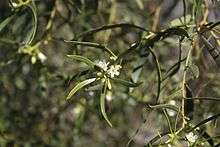Myoporum platycarpum
Myoporum platycarpum, known by a several common names including sugarwood, false sandalwood and ngural[1] is a plant in the figwort family, Scrophulariaceae. It is rounded with bright green foliage as a young shrub and roughly fissured, dark grey bark when mature. Sugarwood is endemic to the southern half of continental Australia.
| Sugarwood | |
|---|---|
 | |
| Myoporum platycarpum growing near Cocklebiddy in the Nuytsland Nature Reserve | |
| Scientific classification | |
| Kingdom: | Plantae |
| Clade: | Tracheophytes |
| Clade: | Angiosperms |
| Clade: | Eudicots |
| Clade: | Asterids |
| Order: | Lamiales |
| Family: | Scrophulariaceae |
| Genus: | Myoporum |
| Species: | M. platycarpum |
| Binomial name | |
| Myoporum platycarpum | |
| Synonyms | |
| |
Description
Sugarwood is a rounded shrub or small tree growing to a height of 10 m (30 ft) with foliage and branches that are glabrous but often covered with small raised, wart-like tubercles. The bark on mature specimens is rough, dark grey, flaky bark. Its leaves are arranged alternately and are usually 37–72 mm (1–3 in) long, 4–9 mm (0.2–0.4 in) wide, linear to elliptic in shape and usually have small teeth or serrations in the outer half. The leaves are often curved or have a hook on the end and both surfaces are deep green in colour.[2][3][4][5][6]
The flowers are borne in groups of about 5 to 8 (sometimes more or fewer) on a stalk 3.8–7.2 mm (0.1–0.3 in) long. The flowers have five triangular sepals and five petals, joined at their bases to form a tube. The petals are white or very pale pink to purple sometimes spotted orange or yellow. The tube is about 1.9–4 mm (0.07–0.2 in) long and the lobes are spreading, blunt and 1.6–4.8 mm (0.06–0.2 in) long. The inside of the tube and part of the lobes are hairy. There are 4 stamens which extend beyond the petals. The main flowering season is from August to November and the fruits that follow are green and fleshy at first but dry when mature.[2][3][4][5][6]
Taxonomy and naming
Myoporum platycarpum was first formally described by botanist Robert Brown in Prodromus Florae Novae Hollandiae in 1810.[1][7]
There are two subspecies:
- Myoporum platycarpum R.Br. subsp. platycarpum[8] has petal lobes that are shorter than the petal tube and as a mature tree has curved or bending branches;[2]
- Myoporum platycarpum subsp. perbellum Chinnock[9] has petal lobes that are equal to or longer than the petal tube and as a mature tree has straight branches.[2]
The specific epithet platycarpum is derived from the ancient Greek platys (πλατύς), broad, flat; karpos (καρπός), fruit.[10] The epithet perbellum is from the "Latin, perbellum very beautiful".[2]
Distribution and habitat
Both subspecies of M. platycarpum occur in inland areas of New South Wales,[3] north-western Victoria[2] and the southern half of South Australia.[5] Only subspecies platycarpum occurs in south-eastern Western Australia[11] and in the far south east of Queensland.[2] It often grows in mallee or Belah woodland.[3]
Uses
Horticulture
Sugarwood is a hardy and attractive plant useful for shade, shelter or as a screening plant in drier climates.[12][13]
Timber
Sugarwood is hard and dense, yellow and streaked brown with small black features. It smells of sugar when it is worked.[14]
References
- "Myoporum platycarpum". APNI. Retrieved 27 November 2015.
- Chinnock, R.J. (Bob) (2007). Eremophila and allied genera : a monograph of the plant family Myoporaceae (1st ed.). Dural, NSW: Rosenberg. pp. 152–155. ISBN 9781877058165.
- "Myoporum platycarpum". Royal Botanic Garden Sydney, Plantnet. Retrieved 27 November 2015.
- "Myoporum platycarpum". Lucid Central. Retrieved 27 November 2015.
- "Myoporum platycarpum". Electronic Flora of South Australia Fact Sheet. State Herbarium of South Australia. Retrieved 13 June 2008.
- "Myoporum platycarpum". Royal Botanic Gardens Victoria, VicFlora. Retrieved 27 November 2015.
- Brown, Robert (1810). Prodromus Florae Novae Hollandiae (Volume 1). London. p. 516. Retrieved 26 November 2015.
- "Myoporum platycarpum subsp. platycarpum". APNI. Retrieved 27 November 2015.
- "Myoporum platycarpum subsp. perbellum". APNI. Retrieved 27 November 2015.
- Backer, C.A. (1936). Verklarend woordenboek der wetenschappelijke namen van de in Nederland en Nederlandsch-Indië in het wild groeiende en in tuinen en parken gekweekte varens en hoogere planten (Edition Nicoline van der Sijs).
- "Myoporum platycarpum K.J.Cowley". FloraBase. Western Australian Government Department of Parks and Wildlife.
- Wrigley, John W.; Fagg, Murray (1983). Australian native plants : a manual for their propagation, cultivation and use in landscaping (2nd ed.). Sydney: Collins. pp. 87–88. ISBN 0002165759.
- "Myoporum platycarpum". South Australian Government Department of Environment, Water and Natural Resources. Retrieved 27 November 2015.
- Allen, Ron. "Sugarwood: Myoporum platycarpum" (PDF). Wood Group South Australia. Retrieved 27 November 2015.